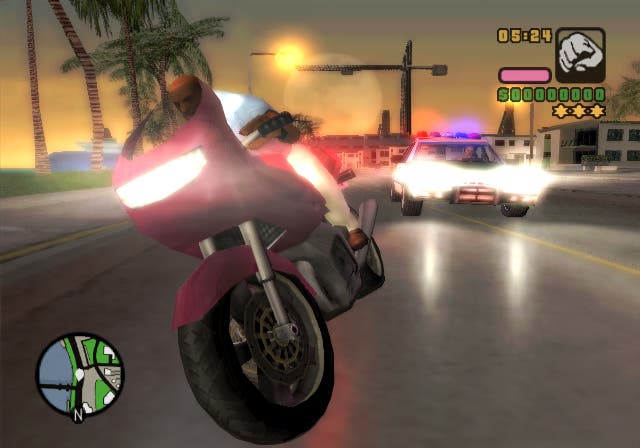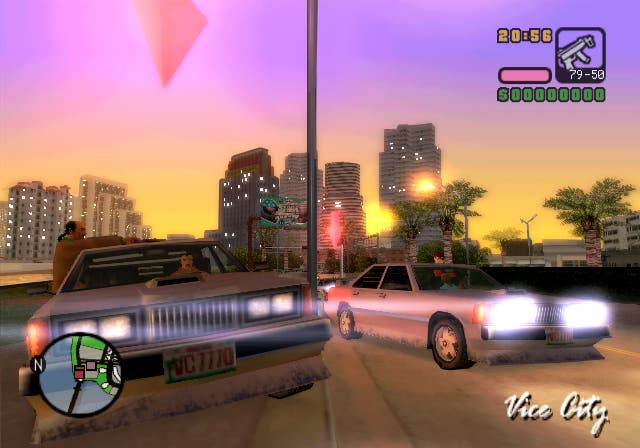Grand Theft Auto: Vice City Stories
Party like it's 2002.
Empirical
Vice City Stories tries to make things more expansive (and therefore more interesting) by introducing a new Empire building element to the gameplay - but compared to other games that have tried it (namely The Godfather) it feels little more than something bolted on that doesn't really add anything more than random battles. Once you've progressed about a quarter of the way into the main missions, you'll notice various businesses appear on the map which you can choose to take over, such as loan sharks, brothels and protection rackets. By simply destroying a car parked out the front, you'll kick off a short-lived battle with various gang members, which then allows you to go inside, kill the remainder of the gang, bust up the furniture and buy the business. At that point you can set up a small, medium or big time business of your choice and watch the money roll in.
If you fancy, you can also partake in some side missions to 'enhance your reputation', but these involve little more than chasing around destroying delivery vans or basic fetch quests. Nothing you haven't done a gazillion times over the past five years, put it that way. In a way, empire building becomes a bit of an irritation in itself, because taking over other gang's businesses will eventually result in them attacking you - meaning you have to engage in wave upon wave of control-deficient combat to protect your turf. As we've already pointed out, that's hardly the best way to spend your time with GTA.

As ever, there are countless other optional side quests that, on paper at least, make Vice City Stories an incredibly good value for money offering. But as nice as it is to be able to dip into vigilante missions, taxi missions, races, rampages and all the others, the incentives to do so are fairly minimal compared to the effort required to clear all of them. Still, if you're the ultimate completist and enjoy mindlessly grinding through dozens of near-identical side portions, you'll be very well serviced. Me? I just wish they'd focus more on making the main dish more exciting than reheating the leftovers yet again.
Avert your eyes
Another unavoidable point to make about Vice City Stories is just how visually impoverished it looks these days. It might look just fine running on the lovely PSP display, but the same cannot be said for how it looks on modern, pin-sharp big screen TVs. Now, a game designed for the PSP was never going to dazzle us on the PS2, but it's quite painful to endure if you've been spending time with next generation games for the past year or so. Vice City was hardly pushing the technical limits of the PS2 back in 2002, so to observe the same game engine more than four years later in a barely modified state is a little depressing. We all know just what the PS2 is capable of, but VCS is a throwback to a time when juddery frame rates, limited animation and dreadfully blocky textured environments were acceptable. If you really haven't had your fill of GTA, do yourself a favour and keep it well away from a big screen high definition TV. We can't be held responsible for the damage that might occur to your mind's eye. Did Vice City really look this bad. Apparently so.

Possibly the one thing that you can't fault Vice City Stories for is the soundtrack. Even in the darkest moments during the game, you can always rely on the radio stations to pull out one absolute corker after another. While Vice City was a masterful exercise in 80s nostalgia, somehow VCS goes far, far further into the deepest recesses of our minds, pulling out not only the big hitters of the time (Relax, Blue Monday, Love Action, It's My Life, Heart of Glass, Wouldn't It Be Good, Sexual Healing), but some real cult classics (Penthouse and Pavement, A Forest, Quiet Life). With over 100 songs in there, it's an incredible journey for anyone who grew up at that time. Far more than the gameplay itself, the radio stations provided the kind of hook that kept us going even when things were getting frustrating. As ever, the chat interludes prove that when it comes to gaming audio, Rockstar is still utterly peerless. It's almost worth buying the game for the radio stations alone, they're that good.

Of course, one of the nicest things about the PSP original was the inclusion of six player multiplayer. Stripped of that novelty, the PS2 port leaves you with an underwhelming and often frustrating solo experience to justify the purchase. You could argue the toss about the game still offering an immense playground to dip in and out of as you see fit, and that's a fair point. But unlike previous GTAs, you've no longer got the novelty of exploration. Sure, some things have been changed and tweaked, but you're fundamentally running and driving around a place that most fans will have already played to death.
Put in context, there's no doubt that Vice City Stories is the weakest in the series to date: Vice City was never the most exciting and varied environment to explore the first time around; simply throwing dozens of uninspired missions at us and an unexciting empire building element into the pot doesn't make up for that. It might be cheap, and it might have more content than Liberty City Stories, and it has gaming audio to die for, but, on balance, Rockstar has milked the flaccid teat of its cash cow to the limit. There are occasional flashes of genius buried under the mountain of samey content in here, but for the most part, Vice City Stories is the kind of release that can only please the shareholders. GTA fans deserve more than this. Luckily, there's not long to wait for a real sequel to banish the memories of this opportunistic filler offering.









